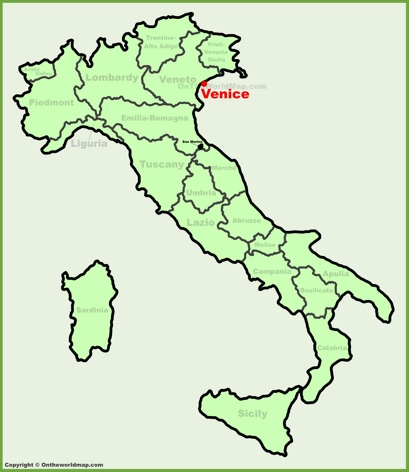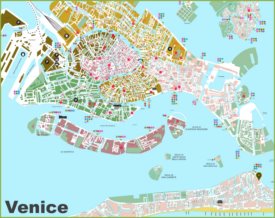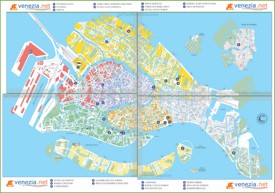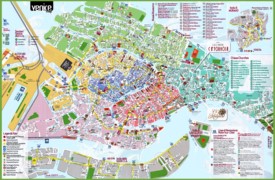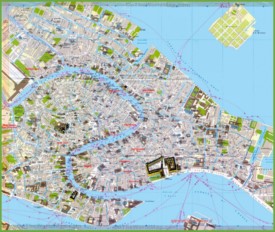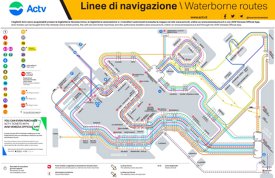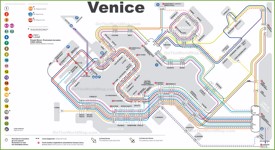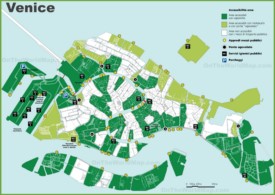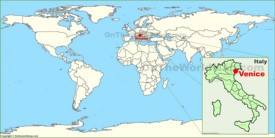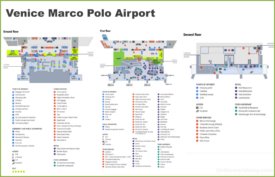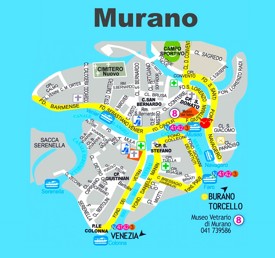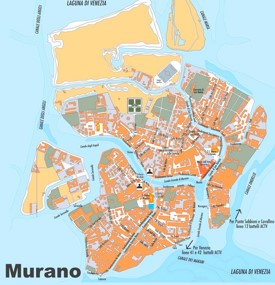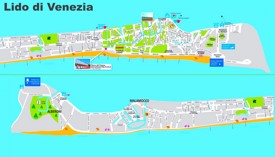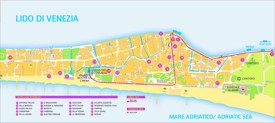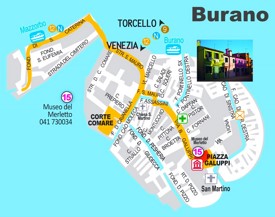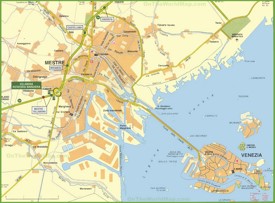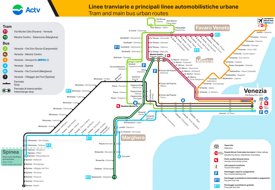Venice Map
Description:
This map shows islands, streets, canals, rivers, buildings, parking lots, shops, churches, restaurants, cafes, hotels, public toilets, museums, piers, railways, railway stations and parks in Venice.
Size: 4893x3275px / 3.95 Mb
Author: Ontheworldmap.com
Map based on the free editable OSM map openstreetmap.org.
You may download, print or use the above map for educational, personal and non-commercial purposes. Attribution is required. For any website, blog, scientific research or e-book, you must place a hyperlink (to this page) with an attribution next to the image used.
Online Map of Venice
Detailed Maps of Venice
Maps of Murano
Maps of Lido di Venezia
Maps of Mestre and Burano
About Venice (Venezia)
Venice, known as Venezia in Italian, is a city in northeastern Italy and the capital of the Veneto region. It is situated on a group of 126 small islands that are separated by canals and linked by over 400 bridges. These islands are located in the shallow Venetian Lagoon, an enclosed bay lying between the mouths of the Po and the Piave rivers. The city is renowned for its stunning architecture and its unique layout, which has earned it the nickname "The Floating City." In 2024, Greater Venice, or Venice Commune, is home to about 250,152 people, of which about 51,000 live on the historic Venice Island and the rest on the mainland.

Venice is famous for its unique architectural style, some of the city's most iconic landmarks include:
St. Mark's Basilica (Basilica di San Marco): A renowned example of Italo-Byzantine architecture, featuring an opulent design with gold mosaics and a blend of Eastern and Western architectural styles. The cathedral, decorated with numerous mosaics made by Byzantine, Venetian, and Roman masters, houses the relics of St. Mark the Apostle and many valuable art objects, including those taken from Constantinople during the Crusades. In 1987, the cathedral, among other Venetian cultural monuments, became a UNESCO World Heritage Site.


Piazza San Marco: the main town square of Venice, Italy. Piazza San Marco is a complex architectural and spatial ensemble dominated by the Campanile (bell tower) of St. Mark's Basilica with a loggetta, which faces the Piazzetta (Small Square) adjoining St. Mark's Square from the southeast. On the Piazzetta are the Doge's Palace, and on the Piazzetta promenade: the Columns of St. Mark and St. Theodore. In Piazza San Marco there are: St. Mark's Cathedral, St. Mark's Clock Tower, the Old Procuracies, the New Procuracies, and the Newest Procuracies.




Doge's Palace (Palazzo Ducale): An outstanding monument of Italian Gothic architecture, one of the main sights of the city. It is located in St. Mark's Square, next to the cathedral of the same name. This main building of Venice was primarily the seat of the Doge of the Republic. The palace was the seat of the Grand Council and the Senate, the Supreme Court, and the secret police. The overhead balcony served as a kind of festive tribune from which the Doge presented himself to the people. Visitors to the city, who docked at the palace itself from the Piazzetta, were thus at the feet of the ruler of the Republic. Together with St. Mark's Cathedral, the Library of San Marco, and other buildings, the Doge's Palace forms the main architectural ensemble of the city.


Rialto Bridge (Ponte di Rialto): One of the four bridges over the Grand Canal in Venice, located in the Rialto district. The first and oldest bridge over the canal. The most famous bridge in Venice and one of the symbols of the city. It is built in the narrowest part of the Grand Canal. Originally it was wooden and repeatedly collapsed. At the end of the XVI century a new stone bridge was built, which has survived to this day. Nearby are the famous Rialto Market and the ancient church of San Giacomo di Rialto.


Grand Canal (Canal Grande): Venice's main waterway, which runs through the entire city, is dotted with more than 170 historic buildings dating from the 13th to the 18th century. Starting in the lagoon at the train station, the canal runs through the city in the shape of an inverted S and ends by joining the San Marco Canal and the La Giudecca Canal at the Customs House. The canal is 3800 meters long, 30 to 70 meters wide, and about 5 meters deep. The canal has almost no embankments, they are replaced by the facades of the houses facing the canal. These houses are usually built on wooden stilts and have two exits - to the land and to the water.


Gallerie dell'Accademia: An art museum housing an extensive collection of Venetian paintings from the 14th to the 18th century, including works by Bellini, Giorgione, Titian, Tintoretto, and Veronese.
Peggy Guggenheim Collection: A modern art museum located on the Grand Canal, featuring works by European and American artists from the first half of the 20th century, including pieces by Picasso, Pollock, and Dalí.
Santa Maria della Salute: A Baroque church built in the 17th century in thanksgiving for the end of the plague. It is noted for its grand dome and location at the entrance of the Grand Canal.

Murano Island: Famous for its long tradition of glass-making. Visitors can explore glass factories and museums showcasing the history and artistry of Murano glass.

Burano Island: Known for its lace-making industry and vibrant, brightly colored houses. The island is a popular day-trip destination for its picturesque scenery.
Teatro La Fenice: One of the most famous opera houses in Italy, renowned for its history and architecture. It has hosted many famous operatic premieres.
Ca' d'Oro (Palazzo Santa Sofia): A palace known as the "Golden House" due to its once gilt and polychrome external decorations. It now houses a museum with a collection of Renaissance art.
Bridge of Sighs (Ponte dei Sospiri): An enclosed limestone bridge with windows, known for the view it offers prisoners on their way to the cells, and its romantic legends.

Venice has a rich history that dates back to its founding in the early Middle Ages. The city became a major maritime power during the Middle Ages and the Renaissance. It was a key player in the Crusades and played a significant role in the commercial and cultural development of Europe. The Republic of Venice was a major financial and maritime power during the Middle Ages and Renaissance, making it a vital center of commerce and art from the 13th to the 17th centuries.
Venice has a long-standing tradition in the arts, particularly in painting, architecture, and music. It was the birthplace of the Venetian School of painting, which includes renowned artists such as Titian, Tintoretto, and Veronese. The city is also famous for the Venice Biennale, a major contemporary art exhibition, and the Venice Film Festival, one of the most prestigious film festivals in the world.
Venice is unique in that it has no roadways, only canals. The primary modes of transportation are boats, including water buses (vaporetti), water taxis, and the famous gondolas. The city is connected to the mainland by the Ponte della Libertà, a long rail and road bridge.


Some more Venice photos from my personal archive









Region: Veneto.
Province: Metropolitan City of Venice.
Area: 160 sq mi (414 sq km).
Population: 250,152.[1]
Postal code: 30100.
Dialing code: 041.
Population: www.comune.venezia.it
References
1. Demografia in cifre. Italian National Institute of Statistics.Maps of Italy
Cities of Italy
Cities of Italy
Regions of Italy


